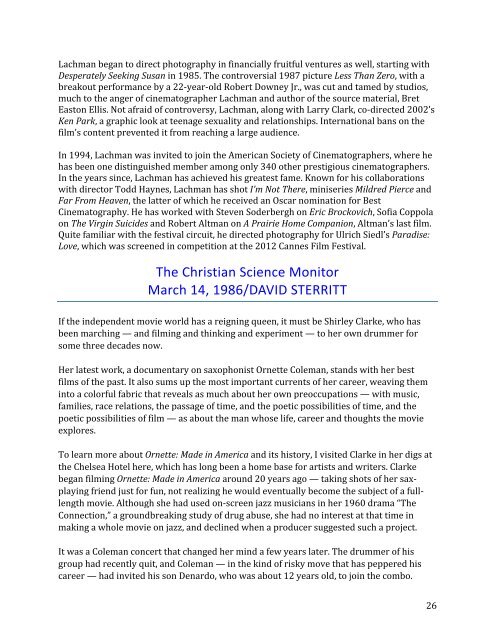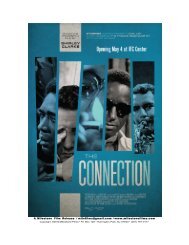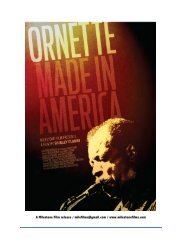ORNETTE Press Kit.8.7.2012 - Shirley Clarke
ORNETTE Press Kit.8.7.2012 - Shirley Clarke
ORNETTE Press Kit.8.7.2012 - Shirley Clarke
- No tags were found...
Create successful ePaper yourself
Turn your PDF publications into a flip-book with our unique Google optimized e-Paper software.
Lachman began to direct photography in financially fruitful ventures as well, starting with Desperately Seeking Susan in 1985. The controversial 1987 picture Less Than Zero, with a breakout performance by a 22-‐year-‐old Robert Downey Jr., was cut and tamed by studios, much to the anger of cinematographer Lachman and author of the source material, Bret Easton Ellis. Not afraid of controversy, Lachman, along with Larry Clark, co-‐directed 2002’s Ken Park, a graphic look at teenage sexuality and relationships. International bans on the film’s content prevented it from reaching a large audience. In 1994, Lachman was invited to join the American Society of Cinematographers, where he has been one distinguished member among only 340 other prestigious cinematographers. In the years since, Lachman has achieved his greatest fame. Known for his collaborations with director Todd Haynes, Lachman has shot I’m Not There, miniseries Mildred Pierce and Far From Heaven, the latter of which he received an Oscar nomination for Best Cinematography. He has worked with Steven Soderbergh on Eric Brockovich, Sofia Coppola on The Virgin Suicides and Robert Altman on A Prairie Home Companion, Altman’s last film. Quite familiar with the festival circuit, he directed photography for Ulrich Siedl’s Paradise: Love, which was screened in competition at the 2012 Cannes Film Festival. The Christian Science Monitor March 14, 1986/DAVID STERRITT If the independent movie world has a reigning queen, it must be <strong>Shirley</strong> <strong>Clarke</strong>, who has been marching — and filming and thinking and experiment — to her own drummer for some three decades now. Her latest work, a documentary on saxophonist Ornette Coleman, stands with her best films of the past. It also sums up the most important currents of her career, weaving them into a colorful fabric that reveals as much about her own preoccupations — with music, families, race relations, the passage of time, and the poetic possibilities of time, and the poetic possibilities of film — as about the man whose life, career and thoughts the movie explores. To learn more about Ornette: Made in America and its history, I visited <strong>Clarke</strong> in her digs at the Chelsea Hotel here, which has long been a home base for artists and writers. <strong>Clarke</strong> began filming Ornette: Made in America around 20 years ago — taking shots of her sax-playing friend just for fun, not realizing he would eventually become the subject of a full-length movie. Although she had used on-‐screen jazz musicians in her 1960 drama “The Connection,” a groundbreaking study of drug abuse, she had no interest at that time in making a whole movie on jazz, and declined when a producer suggested such a project. It was a Coleman concert that changed her mind a few years later. The drummer of his group had recently quit, and Coleman — in the kind of risky move that has peppered his career — had invited his son Denardo, who was about 12 years old, to join the combo. 26




